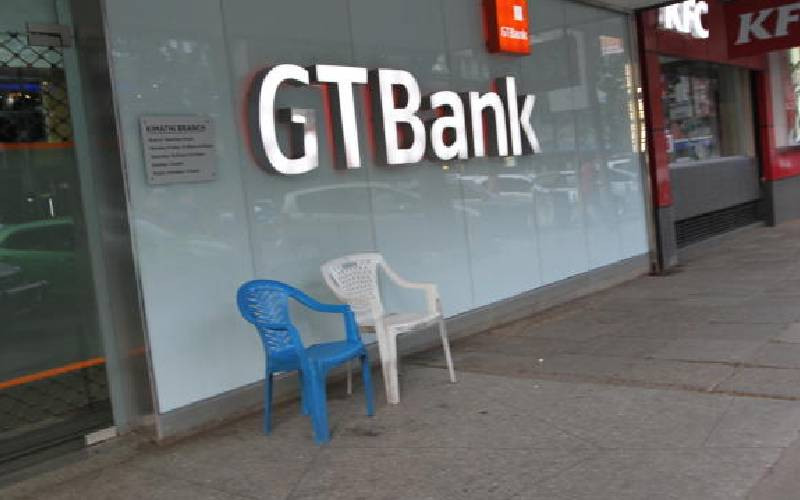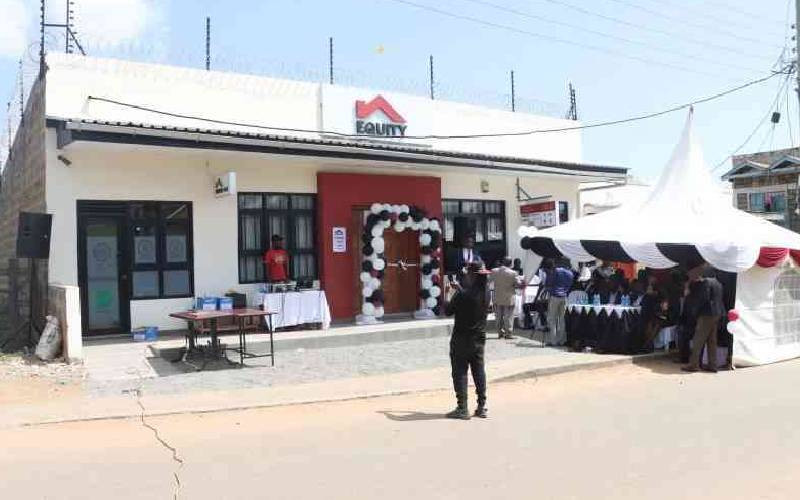A day before Chase Bank experienced a bank run, its customers waited for assurance from the Central Bank of Kenya (CBK) that all was well. It did not come.
CBK Governor Patrick Njoroge, whose appointment to the most important job in the financial sector had injected a lot of confidence, refused to comment on the social media reports that were fanning panic.
Customers became impatient after the bank republished its 2015 financial statements – the second-time round with a disclaimer of opinion from its auditors.
Shortly after, news went out that the bank’s board chairman, Zafrullah Khan, and its managing director, Duncan Kabui, had stepped down.
The fact that Chase Bank was just pulling out of a liquidity crisis further fuelled speculation.
The information vacuum fed into the fears of customers of Chase Bank, especially as Imperial Bank had just months earlier been placed under receivership.
The bank was hit by panic withdrawals of about Sh8 billion in a single day. The following morning, the bank was shut down and Dr Njoroge blamed social media.
And just when the dust was settling on the crisis that led to the closure of three lenders in under nine months, the banking sector has ran into fresh turbulence after legislators passed the Banking (Amendment) Act 2016, to regulate interest rates.
Two weeks down the line, confusion on the new law still reigns.
CBK watched silently as debate raged on whether it was the Central Bank Rate (CBR) or the Kenya Banks Reference Rate (KBRR) that lenders should use to price loans.
Hours to the implementation deadline, the regulator came out and said it was the CBR.
Commercial Bank of Africa (CBA), which had already communicated to its clients that it was going to use the lower KBRR, had to revise its rates upwards to comply.
Confusion now seems to have shifted to mobile-based banking products.
Kenya Commercial Bank (KCB) and Equity Bank are on one side in terms of the application of the law; CBA stands on the other.
Njoroge spoke to journalists last week on some of the issues plaguing the sector, and explained why he handed banks a second blow in one month by lowering the CBR rate.
Stay informed. Subscribe to our newsletter
Excerpts:
What informed the decision of the Monetary Policy Committee (MPC) to cut the CBR to 10 per cent?
We looked at many factors. The headline number for inflation for August was 6.3 per cent and this was driven primarily by food items. Potatoes, tomatoes and cabbages seemed to be the principal commodities that pushed up inflation. The three-month annualised non-food, non-fuel inflation has been declining. These are signs that demand pressures in the economy have abated.
On external sector developments, the current account deficit has been narrowing nicely. At the end of last year, it was at 6.6 per cent of GDP. That has now come down to 5.5 per cent.
Exports have been doing very well, particularly due to higher volumes on tea. Horticultural exports have been doing reasonably well, as well. Remittances have also been strong.
The tourism industry is picking up. The number of forward tourist bookings for October show that 63 per cent of the total hotel capacity is already booked. In November it is 55 per cent and in December it is 51 per cent. These are rather good numbers because it is still early in the US and European source markets for tourists. The bookings are not just in Nairobi. We see this in Mombasa, Eldoret and Nakuru, and it indicates a recovery in tourism.
How are we doing on imports?
Oil prices have allowed us to have lower imports, and there has been also a slowdown in other imports, like manufactured goods obviously associated with the exchange rate movements.
We expect, looking ahead, that there will be large imports related to the SGR at the end of this year and also in quarter one of next year. That is when they will be importing the locomotives and things like that. But we still expect this to be 5.5 per cent of GDP.
Reserves are comfortable. We have an equivalent of an average of 5.2 months of import cover, which I think is at a record. The MPC believes that we have enough buffers to accommodate short-term risks.
What are the risks that the country is looking at at the moment, post the MPC decision?
The global markets remain quite unsettled. China is a concern, but not directly to us because our exports from China are not large.
But the concerns remain the rebalancing that is taking place or that needs to take place. Global growth remains lethargic, and in a sense, the global economy is stuck in neutral. We expect next week [this week] to see revised projections from the IMF [International Monetary Fund] and other actors.
Banks remain the worst hit by the CBR decision. What did you look at in the financial sector?
The distribution of liquidity across banks has improved. You can unwind back to April right after Chase [Bank’s receivership]. We saw soon after that deposits moved from smaller institutions to larger institutions. But now liquidity is much more evenly distributed and stable.
Non-performing loans to gross loans has increased marginally. It was 9.3 per cent in August; in December it was 5.7 per cent. This is a large change, but I think you need to understand what is behind it.
First, it was making sure that banks are classifying loans correctly, and I think you recall the audits of last year.
There is also some increase related to the lethargic growth in private sector credit. When credit growth is rising quickly, NPLS to gross loans fall because you are getting better and better gross loans – the new ones. On the other hand, when private sector credit is not growing, what you see is an edging up of the NPL ratio.
The MPC flagged a slowdown in private sector credit. Can you provide some details?
We saw a slowing down in the growth of private sector credit. Part of it would be a numbers problem; a data issue.
We have looked at it and we are convinced that it is not a data issue. So we need to continue digging there to ensure that data is being filed correctly by banks.
On the numbers, it has gone down from 18 per cent earlier in the year to now 7 per cent. We were thinking that this would be around 12 per cent to 15 per cent; we didn’t expect it to be at 7 per cent and this is the concern of the MPC.
What are the possible causes of the slowdown in private sector credit?
I think I have mentioned one thing, which could be the data and we will continue working on that.
But it could also be a cooling off of the economy in theory, but this is not possible because everything else we are seeing in the economy doesn’t indicate such cooling off. To have such a decline in growth rates, you need to have a substantial slowdown in the economy, which clearly we haven’t seen.
The third reason is that there could be some substitution in foreign assets. For instance, we have had a huge increase in receives. Some large corporations may have received these payments from elsewhere and used these resources to pay their overdrafts. This could be substituting foreign resources for private sector borrowing. But we cannot point to a particular institution that has done this.
Another point is that we have also been seeing delays to vendors or suppliers. When you talk about delays in payments, you generally think Government is not paying on time. Actually, the Government did clear a lot of pending payments in July and they had the resources.
What has also been happening is that large corporates have been asking their suppliers for longer terms on their payment. These are usually between two and three months, but the large corporates are asking for three to five months, which is a new trend. This is worrisome.
If it is confirmed that this is a systemic or wider issue, then this is a source of concern. We have had some representations from institutions, including commercial banks.
Now we have issues on the Banking Amendment Act. There is so much confusion. What has been the impact of this?
The Banking Amendment Act is complicating the conduct of the monetary policy. The MPC decided to lower the signal rate by 50 basis points and thereby signal an easing or loosening monetary policy stance.
Without the caps, the way the signal transmits itself is quite clear. But with the caps, what may happen is that we may have perverse reactions.
The way it should work is that a loosening would lead to an increase in credit across the board, and that would provide some stimulus in the economy.
But with the caps it is not clear which way it will go?
Yes. Existing borrowers will benefit because their rates will come down by that amount, but you do not know what will happen to the riskier borrowers who are at the margins of the cap. They may just be cut off from more lending.
So the perverse reaction is that it may lead to a reduction in lending. It has complicated monetary policy.
When MPC sets the new CBR, are banks required to make the change immediately?
The law says the cap should be CBR plus 4 per cent. Today the CBR is 10 per cent. This means today it’s 14 per cent.
But banks are already sneaking in new fees to circumvent the new law. How are you going to deal with this?
There is a certain procedure in which banks introduce products and so on. You cannot just introduce a new product without approval and so on.
We will follow up on that – we are the regulator after all. I don’t think banks will want to attract the wrath of the regulator. I cannot use hearsay. They have to follow the law.
Have you received any requests from banks to introduce these new fees, and have you approved any?
There hasn’t been a surge in requests on fees as one would suppose. There isn’t anything new and banks need to know how to go about it. But there isn’t a rush by say bank X, Y or Z to request to be allowed to introduce these fees. I would not answer if there is one that has been approved or not.
We have heard nothing so far from microfinance banks. Are they under the new law as well?
I would rather not talk about them now. I have deliberately stayed away from this. Yes, we see all these concerns, but this is not the moment.
We have already been sued, but you will hear us on these matters as well. But we don’t have to be sued to get answers to these questions, but very soon you will hear from us.
Will the new law force a consolidation? Can banks survive on these margins?
There were some banks in which the margins were in the order of 11 per cent, when in comparable countries it would have been something like half of that – like 5 or 6 per cent.
Also on return on equity, on average it is around 30 per cent. In effect, you are getting a full return on your equity in three years. Where else can you get that kind of return?
In Europe, the return on equity is in the order of 5 per cent, in South Africa it’s around 15 per cent – here we are double that.
There is scope for lowering rates, we have said this before – it’s not that we do not believe that rates would have come down.
The elephant in the room is mobile loans. Does the new law include the likes of M-Shwari or not? Also, is the ongoing reclassification of accounts to transactional accounts to avoid paying deposits legal?
Those two questions, I would rather not answer them. In effect that is where the fight is.
Frankly, we are not being fair here. What we are doing here is that if it favours me, I define it in a particular way. There is a bit of that. As a regulator, I cannot be dragged into that. I will take a pass on it.
Surely, isn’t it the role of the regulator to provide clarity on such matters?
The role of the regulator is to implement the law.
There are also cases of re-pricing of loans, and this may just beat the intention of the law, how do you deal with this?
Our view is that we need to provide more information to consumers. There is the element of voting with your feet. Your bank is providing you with particular services or fees or whatever else it is, they are giving you a lot of ‘kizungu mingi’, the customer should really move to another bank and say, okay, this is what my bank is telling me, what do you have to offer?
Give us an update on the three banks that are under receivership and liquidation.
The liquidation of Dubai Bank is progressing well. We have filed some cases against various defendants and we will continue to file more because we have additional information. We have continued to recover assets. We have recovered some assets tied to the former managing director of that institution.
On Imperial Bank, we have reached a rather delicate point of investigation and prosecution. We want to ensure we recover the assets and hold the parties responsible accountable. The forensic audit is largely complete and they are working to ensure that we traverse this rather delicate point, working with relevant investigative and prosecution agencies safely and quickly.
We have been sued on various issues related to Imperial Bank and we have defended our own. We also have a suit we have initiated on WE Tilley and its associates, including some of its directors.
The final case is Chase Bank. This has been a bright spot in all this. It has not disappointed. The changes have included Chase Bank offering a full range of services to its customers. It has continued to open new accounts.
Chase Bank was much more connected than most banks to the SME sector and they will benefit the most from the new loans that can now be provided by Chase Bank. The receiver manager has also met with depositors and institutional investors. I have also met with the institutional investors.
[email protected]
 The Standard Group Plc is a
multi-media organization with investments in media platforms spanning newspaper
print operations, television, radio broadcasting, digital and online services. The
Standard Group is recognized as a leading multi-media house in Kenya with a key
influence in matters of national and international interest.
The Standard Group Plc is a
multi-media organization with investments in media platforms spanning newspaper
print operations, television, radio broadcasting, digital and online services. The
Standard Group is recognized as a leading multi-media house in Kenya with a key
influence in matters of national and international interest.
 The Standard Group Plc is a
multi-media organization with investments in media platforms spanning newspaper
print operations, television, radio broadcasting, digital and online services. The
Standard Group is recognized as a leading multi-media house in Kenya with a key
influence in matters of national and international interest.
The Standard Group Plc is a
multi-media organization with investments in media platforms spanning newspaper
print operations, television, radio broadcasting, digital and online services. The
Standard Group is recognized as a leading multi-media house in Kenya with a key
influence in matters of national and international interest.









